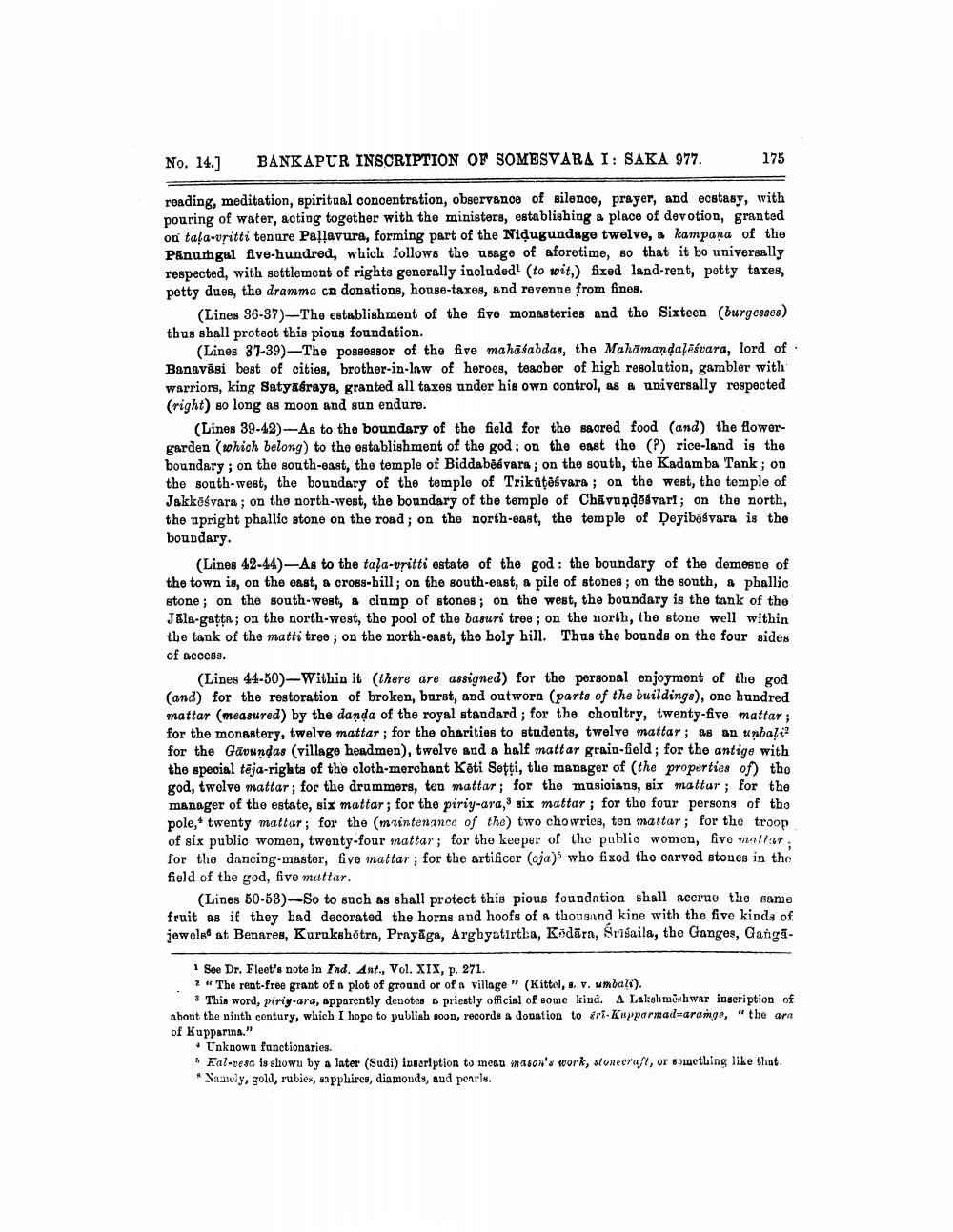________________
No. 14.]
BANKAPUR INSCRIPTION OF SOMESVARA I: SAKA 977.
reading, meditation, spiritual concentration, observance of silence, prayer, and ecstasy, with pouring of water, acting together with the ministers, establishing a place of devotion, granted on tala-vritti tenure Pallavura, forming part of the Nidugundage twelve, a kampana of the Panurgal five-hundred, which follows the usage of aforetime, so that it bo universally respected, with settlement of rights generally included1 (to wit,) fixed land-rent, petty taxes, petty dues, the dramma ca donations, house-taxes, and revenue from fines.
175
(Lines 36-37)-The establishment of the five monasteries and the Sixteen (burgesses) thus shall protect this pious foundation.
(Lines 37-39)-The possessor of the five mahasabdas, the Mahamanḍalēsvara, lord of Banavasi best of cities, brother-in-law of heroes, teacher of high resolution, gambler with warriors, king Satyaéraya, granted all taxes under his own control, as a universally respected (right) so long as moon and sun endure.
(Lines 39-42)-As to the boundary of the field for the sacred food (and) the flowergarden (which belong) to the establishment of the god on the east the (P) rice-land is the boundary; on the south-east, the temple of Biddabesvara; on the south, the Kadamba Tank; on the south-west, the boundary of the temple of Trikütesvara; on the west, the temple of Jakkeśvara; on the north-west, the boundary of the temple of Chavupḍaśvari; on the north, the upright phallic stone on the road; on the north-east, the temple of Deyibēsvara is the boundary.
(Lines 42-44)-As to the tala-vritti estate of the god: the boundary of the demesne of the town is, on the east, a cross-hill; on the south-east, a pile of stones; on the south, a phallic stone; on the south-west, a clump of stones; on the west, the boundary is the tank of the Jala-gaṭṭa; on the north-west, the pool of the basuri tree; on the north, the stone well within the tank of the matti tree; on the north-east, the holy hill. Thus the bounds on the four sides of access.
(Lines 44-50)-Within it (there are assigned) for the personal enjoyment of the god (and) for the restoration of broken, burst, and outworn (parts of the buildings), one hundred mattar (measured) by the danda of the royal standard; for the choultry, twenty-five mattar; for the monastery, twelve mattar; for the charities to students, twelve mattar; as an unbali for the Gavundas (village headmen), twelve and a half mattar grain-field; for the antige with the special tēja-rights of the cloth-merchant Keti Setți, the manager of (the properties of) tho god, twelve mattar; for the drummers, ten mattar; for the musicians, six mattur; for the manager of the estate, six mattar; for the piriy-ara,3 six mattar; for the four persons of tho pole, twenty mattar; for the (maintenance of the) two chowries, ten mattar; for the troop of six public women, twenty-four mattar; for the keeper of the public women, five mattar; for the dancing-master, five mattar; for the artificer (oja) who fixed the carved stones in the field of the god, five mattar.
(Lines 50-53)-So to such as shall protect this pious foundation shall accrue the same fruit as if they had decorated the horns and hoofs of a thousand kine with the five kinds of jewels at Benares, Kurukshetra, Prayaga, Arghyatirtha, Kodara, Srisaila, the Ganges, Ganga
1 See Dr. Fleet's note in Ind. Ant., Vol. XIX, p. 271.
2 "The rent-free grant of a plot of ground or of a village" (Kittel, s. v. umbali).
This word, piriy-ara, apparently denotes a priestly official of some kind. A Lakshmeshwar inscription of about the ninth century, which I hope to publish soon, records a donation to sri-Kupparmad-aramge, "the ara of Kupparma."
Unknown functionaries.
Kal-vesa is shown by a later (Sudi) inscription to meau mason's work, stonecraft, or something like that. Namely, gold, rubies, sapphires, diamonds, and pearls.




